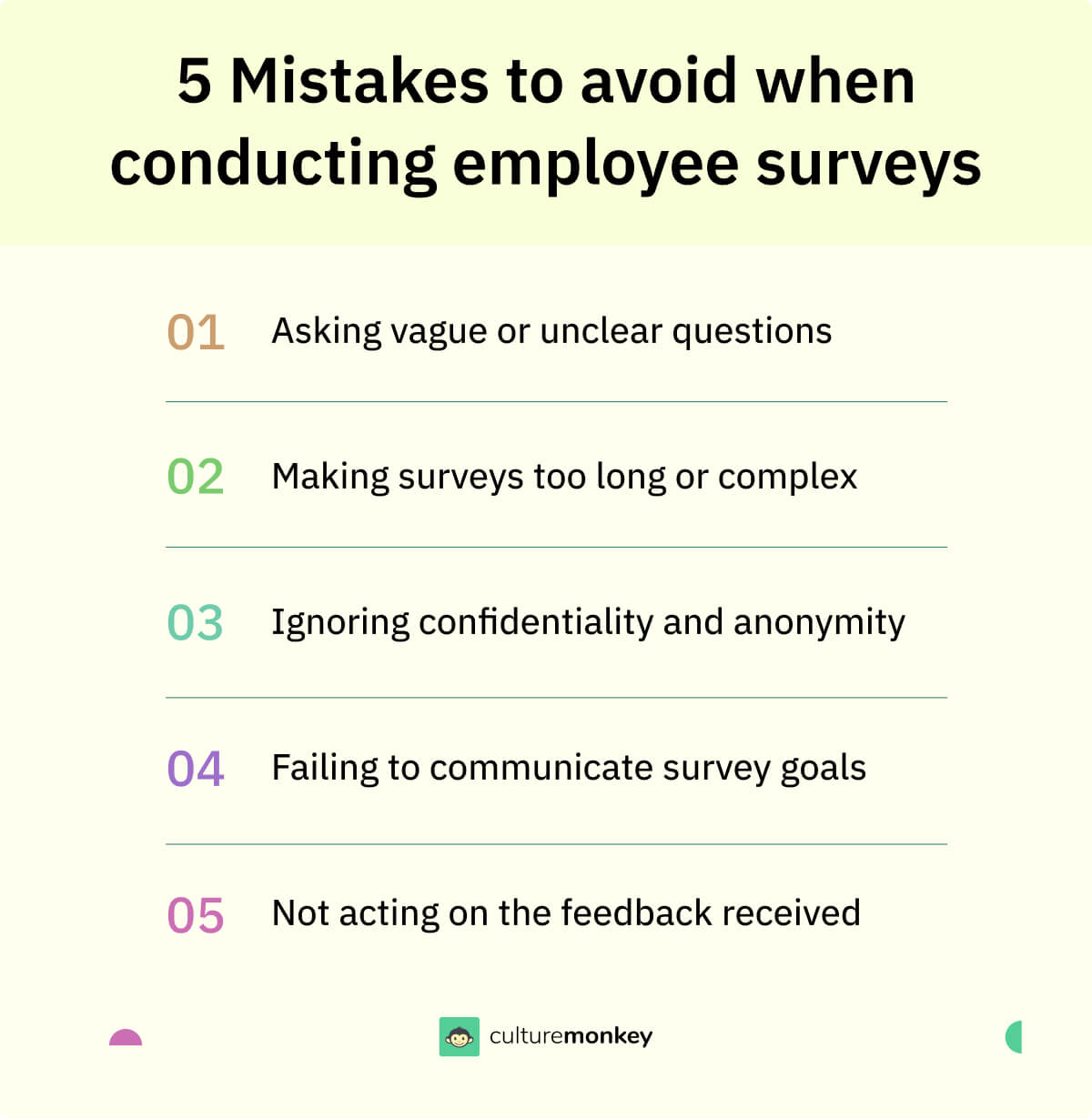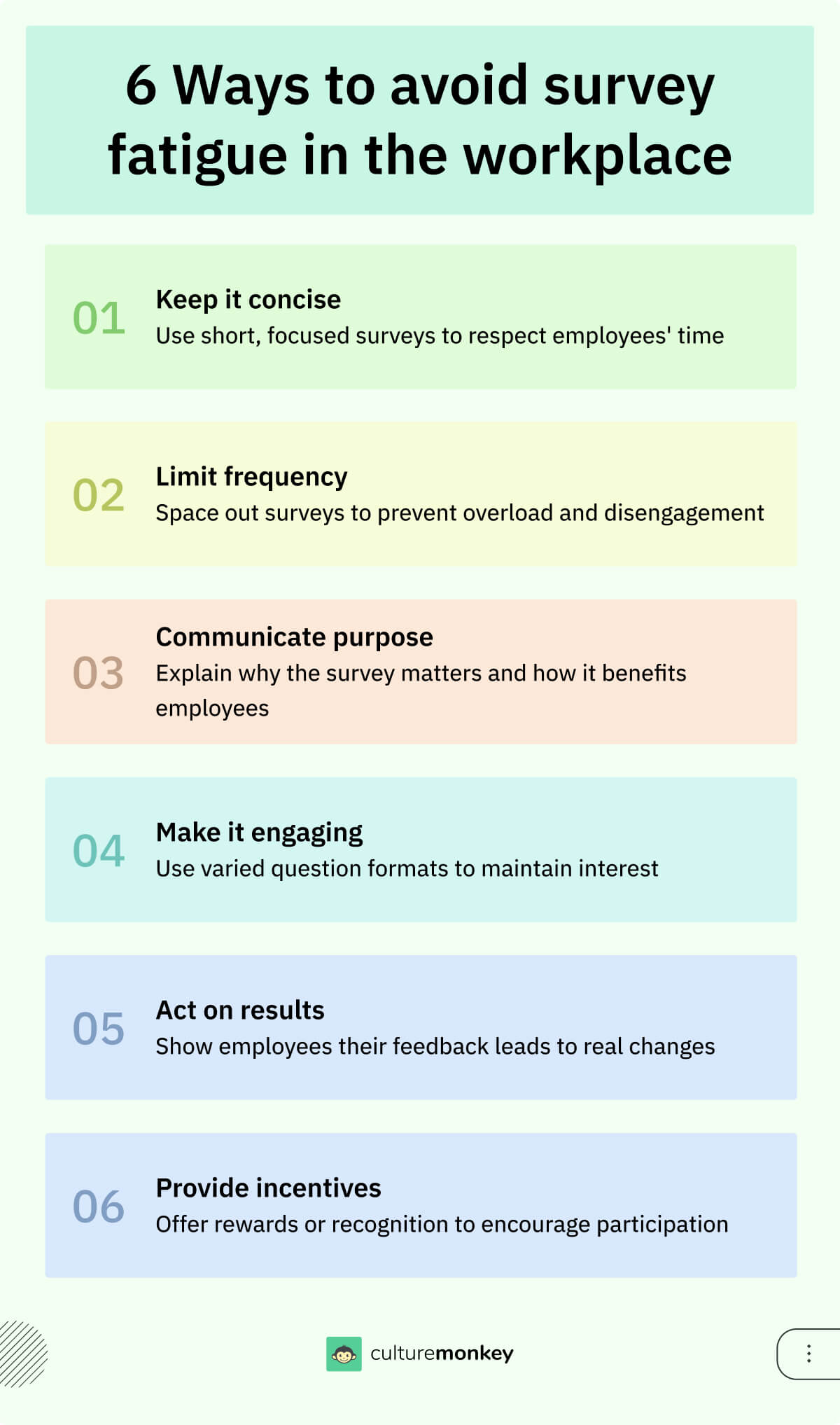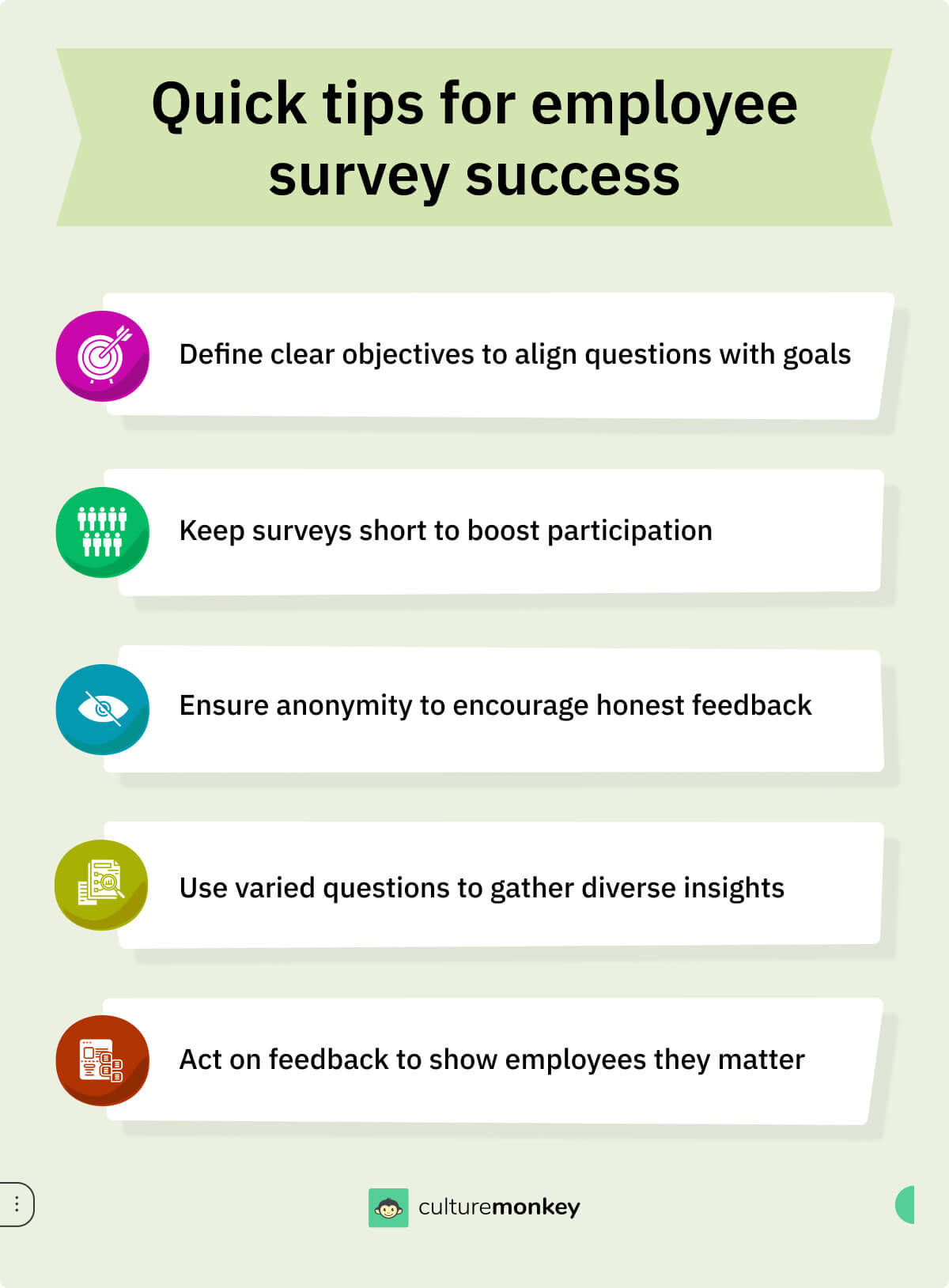Employee survey best practices: 40+ Questions to understand your team better

Imagine running a restaurant where you never ask your diners how their meal was. You assume everything is fine because the plates are empty, but in reality, some customers didn’t enjoy the food, and others were unhappy with the service. Without feedback, you’d never know what to improve, and over time, you’d lose your diners to competitors.
Employee surveys are the feedback cards of your workplace. They help you understand what’s working, what’s not, and where to refine your “menu” of workplace policies and practices.
But creating an impactful survey isn’t just about throwing together questions—it’s about following employee survey best practices to ensure the insights you gather lead to real improvement. Let’s explore how to craft surveys that serve up meaningful results for your organization.
What makes a good employee survey?
Creating a good employee survey is about more than just asking questions; it’s a strategic tool for uncovering insights, fostering communication, and empowering employees. A successful survey begins with clear objectives, ensuring questions align with goals like measuring engagement or gathering feedback on initiatives.
Anonymity and confidentiality encourage honest responses, while relevant, focused, and concise questions respect employees’ time. A mix of question types—multiple-choice, rating scales, and open-ended—provides both quantitative and qualitative data. Regular surveys track progress and trends over time, while transparent communication about the survey’s purpose builds trust.
Acting on feedback is crucial: share findings, involve leadership, and create action plans to address issues and enhance strengths. Inclusive participation across departments ensures diverse perspectives, while benchmarking results against industry standards or past surveys highlights improvement areas. A well-executed survey fosters trust, demonstrates the organization’s commitment to employee well-being, and drives engagement and performance improvements.



Clients do not come first. Employees come first. If you take care of your employees, they will take care of the clients.
Founder
Virgin Group
Types of employee surveys
Here are ten distinct types of employee surveys:
- Employee engagement surveys: Designed to measure the overall employee engagement levels of employees, these surveys assess factors such as job satisfaction, commitment, and motivation.
- Pulse surveys: Short and frequent, pulse surveys provide real-time snapshots of employee opinions on specific issues or events, offering quick and agile feedback.
- Onboarding surveys: Administered during the onboarding process, these surveys gauge new hires' experiences, helping organizations refine their orientation programs.
- Exit surveys: Conducted when employees leave the organization, exit surveys collect feedback on reasons for departure, uncovering potential areas for improvement.
- Diversity and inclusion surveys: Focusing on diversity and inclusion initiatives, these surveys assess employees' perceptions of equity, fairness, and inclusivity within the workplace.
- Training and development surveys: Evaluating the effectiveness of training programs, these surveys gather feedback on the relevance and impact of professional development initiatives.
- Wellness surveys: Addressing employee well-being, wellness surveys explore physical and mental health concerns, helping organizations implement supportive programs.
- Performance feedback surveys: Facilitating continuous improvement, these surveys gather feedback on employees' performance, aiding in constructive feedback and goal setting.
- Leadership and management surveys: Assessing leadership effectiveness, these surveys collect feedback on managerial styles, communication, and team dynamics.
- Remote work surveys: With the rise of remote work, these surveys evaluate the challenges and successes of remote work arrangements, ensuring organizations adapt to evolving work trends.
What are common mistakes to avoid when creating an employee survey?
- Lack of clear objectives: Without a defined purpose, surveys can become unfocused, leading to irrelevant data. Clearly articulate what you aim to achieve, whether it's assessing job satisfaction, identifying training needs, or evaluating workplace culture.
- Using biased or leading questions: Questions that suggest a particular response can skew results. Ensure your questions are neutral to capture genuine employee sentiments.

- Overloading with too many questions: Lengthy surveys can lead to respondent fatigue, resulting in incomplete or rushed answers. Keep surveys concise, focusing on key areas to maintain engagement.
- Neglecting survey flow and structure: A disorganized survey can confuse respondents. Organize questions logically, starting with general topics before delving into specifics, to enhance clarity and completion rates.
- Failing to communicate the survey's purpose: Employees are more likely to participate when they understand the survey's intent and how their feedback will be utilized. Clearly communicate the survey's goals and the importance of their input.
- Not ensuring anonymity: If employees fear repercussions, they may withhold honest feedback. Guarantee anonymity to encourage candid responses.
- Ignoring response rates: Low participation can result in unrepresentative data. Monitor response rates and consider strategies, such as incentives, to boost participation.
- Failing to act on survey results: Collecting feedback without implementing changes can lead to employee disengagement. Demonstrate that you value employee input by taking concrete actions based on survey findings.
Pros and cons of conducting employee surveys
Conducting employee surveys is a strategic approach to understanding workforce sentiments, but it's essential to weigh their advantages and disadvantages.
Pros:
- Enhanced communication: Surveys provide a structured platform for employees to voice opinions, fostering open dialogue and a sense of inclusion.
- Early issue detection: Regular surveys can identify emerging problems before they escalate, allowing for timely interventions.
- Benchmarking progress: Conducting surveys periodically enables organizations to track changes in employee engagement and satisfaction over time, assessing the impact of implemented initiatives.
Cons:
- Resource intensive: Designing, administering, and analyzing surveys require significant time and effort, potentially straining resources, especially in smaller organizations.
- Survey fatigue: Frequent surveys can lead to decreased participation and disengagement, resulting in less reliable data.
- Risk of inaction: Failing to act on survey results can erode trust, as employees may perceive that their feedback is disregarded, leading to decreased morale.
How many questions should an employee survey have?
The ideal number of questions for an employee survey typically ranges between 20 to 40 but can go up to 75. Society for Human Resources Management states that an employee survey should not take more than 30 minutes to complete.
So, striking the right balance is crucial to ensure meaningful responses without overwhelming participants.
A concise survey encourages higher completion rates and minimizes survey fatigue. Focus on key areas relevant to your objectives, including job satisfaction, communication, work-life balance, and organizational culture. Incorporate a mix of question types to gather both quantitative and qualitative data.
Remember, a well-structured survey with reasonable questions enhances the chances of obtaining valuable insights and facilitates actionable changes to improve employee engagement and satisfaction.
40+ Employee survey questions examples
Here are 40+ examples of employee survey questions covering various aspects of the workplace:
- On a scale of 1 to 5, how satisfied are you with your current role and responsibilities?
- Do you feel that your skills and abilities are effectively utilized in your job?
- How satisfied are you with the organization's opportunities for growth and career advancement?
- Are you able to maintain a healthy work-life balance?
- Do you feel supported by the company in managing personal commitments alongside work responsibilities?
- How often do you find yourself working outside of regular working hours?
- Do you feel comfortable sharing your ideas and concerns with your immediate supervisor?
- Are you satisfied with the frequency and effectiveness of communication from the management?
- How well do you think the company addresses employee experience and implements employee feedback?
- Do you believe there is good teamwork and collaboration within your department?
- Are you provided with enough opportunities to collaborate with colleagues from other teams?
- How well does your team handle conflicts and disagreements?
- How would you rate the effectiveness of your immediate supervisor in supporting and guiding your work?
- Do you feel your manager recognizes and appreciates your efforts?
- How satisfied are you with the overall leadership and direction provided by top management?
- Do you feel aligned with the company's mission and values?
- Is the company culture inclusive and supportive of diversity?
- Do you believe the organization prioritizes employee well-being and morale?
- How often do you receive recognition or praise for your achievements?
- Are the existing reward and recognition programs motivating and meaningful to you?
- Do you feel that high performers are appropriately acknowledged and rewarded?
- Are you provided with sufficient opportunities for professional development and training?
- Do you believe the company supports your career growth through learning initiatives?
- How well does the organization nurture talent from within?
- Are you satisfied with the current benefits package offered by the company?
- Do you feel your compensation is fair and competitive for the work you do?
- How well does the company acknowledge and address employees' financial needs?
- How would you rate the organization's initiatives to promote employee wellness and health?
- Do you feel the company adequately addresses mental health concerns among employees?
- Are there sufficient resources and programs in place to support the overall well-being of employees?
- Are the technological tools provided by the company conducive to your productivity?
- Do you believe the organization invests appropriately in keeping technology up-to-date for efficient work?
- How satisfied are you with the training provided for using new technologies within the workplace?
- Does the organization foster an inclusive environment that values diversity?
- Are there initiatives in place to ensure equal opportunities for employees of all backgrounds?
- How well does the company address concerns related to inclusivity and diversity in the workplace?
- How effective do you find the current remote work arrangements provided by the company?
- Are you provided with the necessary tools and support to excel in a remote work environment?
- How well does the organization maintain a sense of connection and collaboration among remote teams?
- How satisfied are you with the feedback and guidance provided during performance evaluations?
- Do you believe the performance evaluation process is fair and transparent?
- Are performance goals clearly communicated, and do you receive constructive feedback for improvement?
Remember, tailoring these questions to match your organization's specific goals and culture will enhance the effectiveness of your employee survey and provide actionable insights to improve employee engagement and satisfaction.

Boost employee survey
participation effortlessly
Engage your workforce with creative strategies—discover proven activities that encourage participation, foster honest feedback, and drive meaningful improvements across your organization.
Why acting on employee feedback is as important as measuring engagement?
Acting on employee feedback is essential for fostering trust, improving morale, and driving organizational success. Here’s why:
- Builds trust and respect: Shows employees their opinions matter, enhancing morale and loyalty.
- Identifies key issues: Serves as a diagnostic tool to pinpoint challenges and productivity roadblocks.
- Enables targeted interventions: Helps HR and leaders address specific concerns and implement effective solutions.
- Demonstrates adaptability: Keeps organizations attuned to evolving employee needs and expectations.
- Boosts retention and attraction: Creates a responsive, employee-centric environment that retains top talent and appeals to skilled professionals.
- Encourages continuous improvement: Fosters a culture of open communication and constructive feedback.
- Drives innovation: Promotes collaboration and creativity, enhancing problem-solving across teams.
- Generates a ripple effect: Tangible action on feedback inspires employees, increasing their investment in organizational success.
- Improves performance: Heightened engagement and motivation lead to better individual and business outcomes.
Why you should worry about employee survey participation?
Employee survey participation is not just a mere formality; it holds immense significance in shaping the success and well-being of an organization. Here are compelling reasons why employers should prioritize and worry about employee survey participation:
- Representation of employee voice: Employee surveys serve as a powerful platform for employees to voice their opinions, concerns, and suggestions. High employee response rates ensure a more accurate representation of the workforce's diverse perspectives, experiences, and needs. It helps employers understand the collective sentiments and aspirations of their employees, leading to informed decision-making.
- Validity and reliability of data: A low response rate in employee surveys can compromise the validity and reliability of the data collected. A small sample size may not accurately reflect the true state of affairs, making it challenging to draw meaningful conclusions or identify patterns. Encouraging widespread participation in workplace surveys ensures a robust dataset, bolstering the survey's credibility and subsequent actions based on its findings.

- Employee engagement and trust: The act of participating in surveys itself demonstrates that the company values employees' input and trusts their judgment. This fosters a sense of inclusion, openness, and transparency, which are essential for cultivating high employee engagement and building a positive organizational culture.
- Identifying organizational blind spots: Low survey participation can lead to critical blind spots, as important issues or areas of improvement may go unnoticed. Unaddressed concerns can fester over time, potentially leading to employee dissatisfaction, disengagement, and even turnover. Encouraging participation helps organizations stay proactive in addressing challenges before they escalate.
- Driving meaningful change: The purpose of conducting employee surveys is to drive positive change within the organization. A high participation rate in engagement survey signifies that employees are invested in the organization's success and are willing to be a part of the transformation process. Their input paves the way for targeted improvements that lead to a more productive and satisfied workforce.
- Employee satisfaction and retention: Actively involving employees in the survey process demonstrates that their opinions matter and are taken seriously. This, in turn, enhances their job satisfaction and strengthens their commitment to the company. Satisfied employees are more likely to stay loyal to the organization, reducing turnover and associated costs.
- Employee wellness and productivity: Employee surveys often touch upon aspects like work-life balance, well-being, and job satisfaction. Addressing these concerns through survey results can lead to a healthier and more productive workforce, with employees feeling supported in both their personal and professional lives.
- Enhancing communication channels: A high participation rate in employee surveys signifies an engaged and communicative workforce. It establishes a foundation for effective communication channels between employees and leadership. Regular survey participation fosters an environment where employees feel heard and valued, contributing to improved internal communication strategies.
- Tailoring organizational strategies: A robust participation rate allows organizations to tailor their strategies based on the specific feedback received. Whether it involves refining policies, introducing new initiatives, or addressing identified concerns, a diverse and comprehensive set of responses enables organizations to customize their approaches for maximum impact.
- Fostering innovation and creativity: Employee surveys can be a source of innovative ideas and creative solutions. Actively involving employees in the survey process not only gauges their satisfaction but also taps into their insights for potential innovations. High participation rates contribute to a culture that encourages employees to share inventive suggestions, driving organizational innovation.
- Building a sense of ownership: Encouraging participation in surveys instills a sense of ownership among employees regarding the organization's development. When employees actively contribute to shaping the workplace through surveys, they feel a stronger connection to the company's mission and vision, fostering a collective sense of responsibility for its success.
What’s the right time to run employee survey?
Conducting employee surveys at the right time is imperative to gather accurate and insightful feedback from your workforce. The timing of these surveys can significantly impact the quality and relevance of the data collected.
- Seasonal considerations: Initiating surveys during periods of organizational stability, avoiding peak workloads, or aligning with natural business cycles ensures that employees can dedicate sufficient time and attention to providing thoughtful responses.
- Strategic planning milestones: Integrating surveys with strategic planning milestones allows organizations to align employee feedback with broader organizational goals. This ensures that the insights garnered contribute directly to the development and refinement of strategic initiatives.
- Post-change assessments: Following significant organizational changes, such as mergers, restructuring, or leadership transitions, is an opportune time for surveys. This allows organizations to assess the impact of these changes on employee morale, engagement, and overall job satisfaction.
- Regular pulse check-ins: Incorporating regular pulse surveys throughout the year provides a continuous feedback loop. This agile approach allows organizations to stay attuned to evolving employee sentiments, enabling swift responsiveness to emerging concerns or positive trends.
- Employee life cycle events: Capitalizing on key events in the employee life cycle, such as onboarding, work anniversaries, or performance reviews, ensures that feedback is collected at moments when employees may have distinct insights into their experiences.
5 Best practices to conduct a proper workplace survey
Gallup study shows that organizations that follow best practices see an engagement of 72% with their employees. Here are 5 employee engagement survey best practices to follow in order to conduct a workplace survey the right way.
- Define the purpose and goals of the workplace survey. Have a focused approach to gathering specific insights that align with the organization's priorities.
- Ensure employee survey responses are anonymous and confidential to encourage honest feedback without fear of reprisal.
- Craft clear and relevant survey questions that align with the objectives. Use a mix of question types to gather both quantitative and qualitative data.
- Conduct surveys at regular intervals to track progress and identify trends over time. Timing is essential to capture relevant feedback.
- Communicate the survey's purpose and results to employees. Act on the feedback received and implement changes based on the survey findings, demonstrating a commitment to improvement and improving employee engagement and satisfaction.

Measuring employee engagement and acting on the results
Once the data is gathered, it is imperative to translate these insights into actionable strategies that foster a positive work environment and drive continuous improvement.
- Comprehensive analysis: The first step after conducting an employee engagement survey involves a thorough analysis of the results. Identify patterns, key themes, and areas of strength or concern. Understanding the nuances of the data allows for targeted and effective action planning.
- Identifying priorities: Prioritize the aspects of employee engagement that require immediate attention. This could range from addressing specific concerns raised by employees to reinforcing and celebrating successful practices within the organization.
- Communication and transparency: Following the analysis, communicate the survey findings transparently to the workforce. Transparency cultivates trust and reinforces the organization's commitment to addressing concerns and leveraging strengths identified by employees.
- Action planning: Develop a strategic action plan based on the survey results. This plan should outline specific initiatives, timelines, and responsible parties for implementing changes. Align these actions with organizational goals to ensure a cohesive approach.
- Continuous feedback loop: Employee engagement is an ongoing process. Establish mechanisms for continuous feedback and improvement. Regularly revisit survey results to track progress, assess the impact of implemented initiatives, and adapt strategies as needed.
Conclusion
Employee surveys play a pivotal role in modern organizations, providing invaluable insights into employee sentiments and needs. When conducted with clear objectives, thoughtful design, and a commitment to action, these surveys become powerful tools for enhancing employee engagement, satisfaction, and overall organizational success.
If you want to start measuring employee engagement at your workplace and collect employee feedback, CultureMonkey can help you listen to your employees better and create more growth opportunities with its employee engagement survey platform.
It offers multiple survey options such as eNPS, pulse surveys, and employee life cycle surveys to accurately measure the engagement levels of your employees and improve it.
Companies can take anonymous feedback in real-time and ensure their employees are not facing any major roadblocks. It can also help find areas of focus that the management needs to work on to improve employee retention and engagement.
Summary
Conducting employee engagement surveys helps organizations evaluate workforce satisfaction, motivation, and overall commitment. These surveys focus on critical areas such as workplace culture, communication effectiveness, and employee well-being.
By leveraging best practices, organizations can design surveys that provide meaningful insights, drive strategic improvements, and enhance the employee experience. This leads to higher engagement, improved retention, and long-term organizational success.
FAQs
1. What are the best practices for designing effective employee survey questions?
Designing effective best practices for employee engagement survey questions involves clarity, relevance, and neutrality. Craft questions that address specific organizational objectives, avoid leading language and allow for unbiased responses. Ensure questions are concise, easily understandable, and cover diverse aspects of the employee experience. Pilot testing can help refine questions before the survey rollout, enhancing the quality of survey data collected.
2. How often should employee surveys be conducted for optimal results?
The frequency of employee surveys depends on organizational dynamics, but a balance must be struck to avoid survey fatigue. Quarterly or biannual surveys are common, providing regular insights without overwhelming employees. Conduct employee engagement surveys or pulse surveys for more frequent, targeted feedback on specific issues. Ultimately, the optimal frequency varies, and organizations should align survey schedules with their goals.
3. What actions can organizations take based on employee survey results?
Organizations can leverage employee survey results to implement targeted actions. Address identified concerns promptly, communicate transparently about planned improvements, and celebrate areas of success. Establish action plans with clear timelines and allocate resources strategically. Encourage ongoing feedback to monitor the impact of initiatives. By actively engaging with survey findings, organizations foster a culture of continuous improvement, enhancing employee satisfaction.
4. What is the ideal number of questions in an employee survey?
The ideal number of questions in an employee survey balances comprehensive data collection with respondent engagement. Aim for a focused set of questions that address key aspects of employee experience and organizational objectives. Generally, surveys with 20-30 questions maintain respondent interest and yield meaningful insights. Avoid excessive length to prevent survey fatigue, ensuring a higher response rate and more accurate data.
5. What are the guidelines for employee surveys?
Employee survey guidelines encompass several key principles. Ensure anonymity and confidentiality to encourage honest responses. Communicate the survey's purpose, benefits, and timeline transparently. Use a mix of question types, including scaled responses and open-ended questions, for a comprehensive understanding. Tailor surveys to organizational goals and employee demographics. Pilot test questions to refine and validate their effectiveness.

